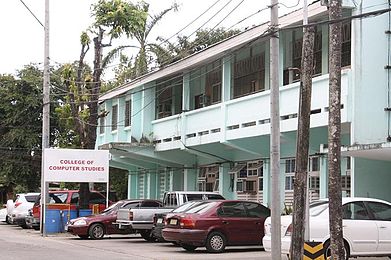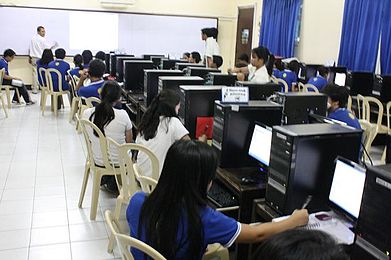- College of Computer Studies
-
College of Computer Studies Kolehiyo ng Araling Pang-Kompyuter Established 2003 Type Private Dean Engr. Cirilo Calibjo Academic staff 15 Admin. staff 7 Undergraduates 862 Location Jaro, Iloilo City Campus Urban Colors Green Nickname CCS - Eco Warriors Website www.cpu.edu.ph The College of Computer Studies (CCS) is one of the 12 colleges of Central Philippine University. The college was formally established in 2003, under the presidency of Dr. Juanito Acanto.[1] The College of Computer Studies offers the three fundamental courses in[2]Information Technology: the Bachelor of Science in Computer Science, Bachelor of Science in Information Technology and the Bachelor of Science in Information Systems. The college also offers Master in Computer Science (MCS) and Master of Science in Computer Science (MSCS). It is a certified CISCO Networking Academy and a member of Oracle Academic Initiative. The dean of the college is Engr. Cirilo Calibjo.
Contents
History
Computer Science (1995–1998)
The college began in 1995 with the birth of the Bachelor of Science in Computer Science (BSCS) program under the College of Commerce. The first batch of students was composed of two sections with about 100 students. Prof. Mary O’ T. Penetrante was appointed to be the faculty-in-charge of the new program. She was assisted by Mr. Jojee Roy Juarez who handled the programming subjects of the fledgling program.
After two years and more students, the university deemed that the BSCS program was stable enough to merit the right to have its independent administrator. In 1997, the BSCS program became a bona fide department of the College of Commerce with Prof. Penetrante, its first department head. Prof. Aquiles Sansing, Mr. Aldwin Alojipan and Mr. Nick Gazo were among the first faculty members. The department had an enrollment of 300 students.
The following year, the number of students enrolled had reached almost 500. The administration deemed it necessary to construct additional laboratories and hire more teachers.
Computer Science and Software Engineering (1999–2002)
By the first semester of school year 1999–2000, the CS Department Office was relocated from the Dean’s Office of the College of Commerce (where it had been housed from the start) to the Mary J. Thomas Building (MT) where it is to this day.
The three existing laboratory rooms were transferred from the New Valentine (NV) Building to the second floor of the Mary J. Thomas Building. An additional computer laboratory with internet capability was supplemented to further serve the needs of the growing number of students.
By the end of that school year, changes on the management of the department was planned based on the memorandum for the Commission on Higher Education (CHED) that all computer-related courses should be under one college or academic unit for efficient administration.
During the first semester of SY 2001–2002, the CS Department was transferred to the College of Engineering to be managed with the newly offered Bachelor of Science in Software Engineering (BSSE) course. It was called the Software Engineering and Computer Science (SE & CS) Department and was headed by Engr. Cirilo Calibjo, PEE. The students faced major adjustments because they had to adapt to the rigorous discipline of engineering mathematics and other Electrical Engineering subjects taught by engineering faculty. This decreased the population of the department.
Despite the difficulties, there were positive improvements in the form of faculty development programs through seminars and trainings local and abroad. A change of management brought about change in the number faculty of the department because some instructors had chosen to remain under the College of Commerce.
In the College of Commerce, new developments continued. Since information management and computerization became and integral component of the business sector, the college introduced the Bachelor in Information Science and Management (BISM) which was the brainchild of Prof. Aquiles Sansing.
Birth and initial growth (2002–2005)
At the end of school year (SY) 2002–2003, it was proposed that the CS Department under the College of Engineering and the Information Science Management under the College of Commerce, along with another new course, Bachelor of Science in Information Technology (BSIT) would be combined under one college. The university approved and implemented the proposition.
On the first semester of SY 2003–2004, the College of Computer Studies began. Engr. Cirilo Calibjo, the chair of the Software Engineering & Computer Studies in the College of Engineering, became its first Dean. The new college was again housed in the Mary Thomas Building.
The new college reunited former colleagues and resulted in a happy mix of experienced teachers and eager new instructors. More changes were made to optimize the course offerings of the College of Computer Studies in 2004. The college proposed revisions; all were approved by the university. In March 2004, some subjects for BSCS and BSIT were changed, and BISM was renamed as Bachelor of Science in Information Management (BSIM).
In April 2004, two new degree courses, Master in Computer Science (MCS) and Master of Science in Computer Science (MSCS), were approved. These were implemented in the first semester of SY 2004–2005.
Further growth, development programs and CISCO (2006–2008)
During the First Semester of SY 2006-2007, Engr. Calibjo went to Manila to pursue doctoral studies in Electrical Engineering at the University of the Philippines, Diliman. Prof. Rodney A. Gicana was appointed as the Officer-in-Charge during his absence. Prof. Gicana was previously the Department Head of the Software Engineering Department.
During this school year the Ladderized Education Program (LEP) under the Technical Education and Skills Development Authority (TESDA) was implemented through the BSIT course. Under the program three competencies were Personal Computer Operations (PCO) NC II (Ladder 1), Computer Hardware Servicing (CHS) NC II (Ladder 2) and Computer Programming (CP) NC IV (Ladder 3). Scholarships were provided by the government through TESDA to aid the students. At this time the enrollment boasted more than 6,000 students.
During the second semester of 2006, the college became a CISCO Networking Local Academy[3] under the supervision of the University of Cebu (UC) as its regional academy. Also in this semester the name of the Bachelor of Science in Information Management (BSIM) was changed to Bachelor of Science in Information Systems (BSIS) pursuant to CHED Memorandum Order (CMO) No. 53, Series of 2006.
The college opened its doors to professional training in computer networking technology using the CISCO Discovery curriculum.[4] The classes were held on Saturdays for 10 hours per module. During its first opening, more than 20 professionals enrolled.
To meet the increase in population, a laboratory was added to house the CISCO Laboratory at MTR3.
Present (2009– )
On the first semester of SY 2009–2010 the college enrollment increased to more than 800 students, with BSIT having the most enrollees. New programs are envisioned to meet the demands of the industry and make the college true to its mission and vision of becoming the premiere institution in information technology education in the region.
Degree offerings
Undergraduate degree programs
- BSCS: The Bachelor of Science in [Computer Science] is the systematic study of computing systems and computations. The body of knowledge resulting from this discipline contains theories for understanding computing systems and methods; design methodology, algorithms, and tools; methods for the testing of concepts; methods of analysis and verification; and knowledge representation and implementation.
- BSIT: The Bachelor of Science in [Information Technology] is similar to the Computer Science in terms of its scope of study; the study of systematic computation, understanding computing systems and methods, design methodology, algorithms and tools; methods for the testing of concepts; methods of analysis and verification and knowledge representation and implementation. Though they have certain similar functions, Information Technology manipulates and put to use these functions and methods to transform the way we work and the products found in the market today. Information Technology interacts with customers and uses the computer and the web to maximize the use of information so that it has significance in the computer and business environments.
- BSIS: The Bachelor of Science in Information Systems integrates strong business background with advance training in applying information technology to management. In addition to taking introductory courses in accounting, finance, management, entrepreneurship, production, marketing, and other business related courses, students learn to design information systems serving management and supporting its decision functions. This course offers the essential knowledge for relating the most up-to-date information technology to business and organizational needs with a focus on the emerging strategic role of information systems. The course explores the rules of information system in capturing and distributing organizational knowledge and in enhancing management decision making.
Graduate degree programs
- Master of Computer Science
- Master of Science in Computer Science
Linkages
The College of Computer Studies have linkages with IT, business companies in the Philippines.[5]
- Phil. Society of IT Educators (PSITE)
- ORACLE - Philippines
- Software Venture, International
- Corporate Information Solutions, Inc.
- Bayan Telecommunications Inc.
- Bluepoint Institute of Higher Tech.
- Development Bank of the Phil.
- Asian Business Solutions, Inc.
- PACE of Malacañang
- BPI – IT Department
- Medilink Inc.
- National Computer Center
- Innovative Training Works, Inc.
- MSI Digiland, Inc.
Notes and references
External links
- Official website of Central Philippine University
- College of Computer Studies - CPU website
- CCS - CPU Facebook Fan Page
People William Valentine • Hopevale Martyrs •Campus University Church • CPU-CAS Butterfly Garden • University Library • Wall of Remembrance • Alumni Promenade-Concert Park/CPU Alumni Promenade • Alumni Garden • Santos Park • CPU Botanical Garden • Nuñez Centennial Garden • Prayer Garden • CPU Swimming Pool • Centennial WalkwayCentraliana CPU Handbell Choir • Centralian Songs • CPU Alumni Association • Distinguished Centralians • Centennial CelebrationMedical Facilities University Clinic • CPU Birthing Center • CPU Clinical Laboratory • CPU KABALAKA Reproductive Center • Iloilo Mission Hospital • Capiz Emmanuel HospitalMedia Central Echo • The Link • CPU TV Channel
To place a file in this category, add the tag {{[[Template:{cc-by-sa-3.0|{cc-by-sa-3.0]]}} to the bottom of the file's description page. If you are not sure which category an image belongs to, consult the appropriate tag page. If this category is very large, please consider placing your image in a new or existing subcategory. Free images can be moved to the Wikimedia Commons. Categories:- Universities and colleges in the Philippines
- Educational institutions in Iloilo
Wikimedia Foundation. 2010.




